DO-IT News August 2020

Volume 28, Number 2
Below are the articles of the DO-IT News August 2020 newsletter. These articles can also be seen all on one page at the Full Newsletter option.
Meet the 2020 Scholars!
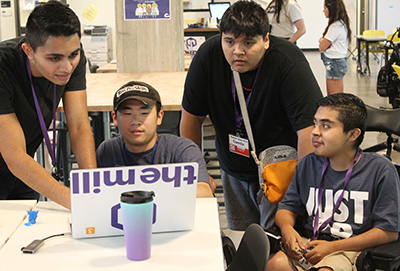
Social and medical crises of the last few months have led many of us to feel like everything has changed! Statistics, social distancing, hand sanitizers, facial masks, and protests dominate the daily news. As each day seems to bring a new “normal,” we have all been challenged to achieve balance in our lives that addresses our personal needs as well as those of others in order to create a more equitable and healthy world for everyone. These concerns have tested DO‑IT’s agility as we adapted our DO-IT Summer Study—which, for twenty seven years, has been offered on the University of Washington campus—to an online program. Information about the award-winning DO-IT Scholars can be found at uw.edu/doit/programs/do-it-scholars. We are learning how, even with major changes in delivery, some things have not changed: DO-IT can still provide participants with opportunities to learn about postsecondary education, life on a college campus, challenging academic and career fields, networking, and technology as an empowering tool, as well as have some fun along the way.
I am pleased to introduce to you the 2020 Scholars:
Angela enjoys taking science and history classes at Mountlake Terrace High School. To prepare for a career in medicine or biochemistry, she is planning to earn a masters degree in biology or chemistry. Angela has spinal muscular atrophy.
Anthony attends Shorewood High School, where his favorite courses are mathematics and Mandarin. He enjoys Mandarin because he has traveled to China and likes the culture and language. Anthony has autism. After he graduates from college, he wants to work in a tech field.
Audrey attends Redmond High School. Her favorite courses are physical education and art. She wants a career that involves art, possibly creating animated movies, TV shows, and games. Audrey has autism.
Braxton enjoys taking English and foreign language courses at Ridgefield High School. After high school, Braxton plans to attend a 4-year college to get a degree in linguistics to prepare for a career in computational linguistics. Braxton has cerebral palsy.
Charlie, who has cerebral palsy and a speech impairment, attends Edmonds Woodway High School. His favorite subjects are computer science and science. Charlie wants to work in a field that involves computers and possibly working for Microsoft one day.
Clarice enjoys English and chemistry courses at Newport High School and likes to read books and write essays. In the future, Clarice is interested in being an elementary school teacher or a caregiver. Clarice is deaf.
Esteban attends Quincy High School, and he has a vision impairment. He enjoys ceramics and science. After high school, Esteban wants to attend a 4-year college to study animation or something in the medicine field.
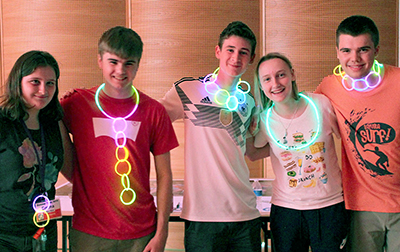
Ethan enjoys taking physical education and history courses at Sammamish High School. Ethan plans to attend college to prepare for a career in journalism, video production, and sports media. His dream career is to be a sportscaster. Ethan has autism.
Iris attends Quincy High School and enjoys math and art classes because they inspire her to do new things. After high school, Iris plans to attend a university to prepare for a career in a medical field. Iris has a vision impairment.
Mallory enjoys taking American Sign Language and history. She attends Sedro-Woolley High School. Mallory has a learning disability. She enjoys working with kids, volunteers in a classroom, and plans to become a teacher in early education.
Manuel goes to school at Eastside Academics, where his favorite courses are biology and health. He plans to study biology, mental health, and nutrition in college. Manuel’s career goal is to become a therapist. Manuel has anxiety, attention deficit hyperactivity disorder (ADHD), and autism.
Marcos enjoys studying computer science and chemistry at Mountlake Terrace High School. Marcos is interested in programming and looks forward to developing his own computer programs. Marcos has a learning disability.
Mariana attends Summit Atlas Public School where math and English are her favorite courses. Mariana has a learning disability. Mariana wants to attend a university and become a veterinarian.
Matthew enjoys Science Olympiad and his history class. At Raisbeck Aviation High School, Matthew completed two Teen Police Academies, and wants to study criminal justice at a university. Matthew has dyslexia.
Michael attends West Seattle High School and has ADHD, autism, and obsessive-compulsive disorder. His two favorite courses are science and art, but he has specific interests in botany, entomology, and conservation. Michael plans to study agriculture and engineering in college.
Miles likes taking journalism and computer skills classes at Inglemoor High School. Miles wants to study history, statistics, and journalism in college. He is passionate about sports and would like to pursue sports journalism. Miles has Asperger syndrome.
Mya, who has dyslexia, attends the Science and Math Institute. Mya’s favorite courses are math and science. In college she plans to prepare for a career as a veterinarian who works with exotic animals.
Raelynn enjoys taking chemistry and computer science classes and codes for a hobby. After college, Raelynn wants to become a chemist or a bioengineer to help mitigate environmental challenges. She has attention deficit disorder, autism, dysgraphia, and dyslexia.
Zayn attends Skyline High School and is deaf. Her favorite subjects are math and science. She enjoys solving problems algebraically. In college, Zayn wants to study to become an audiologist.
DO-IT Director Wins Diversity in Technology Award
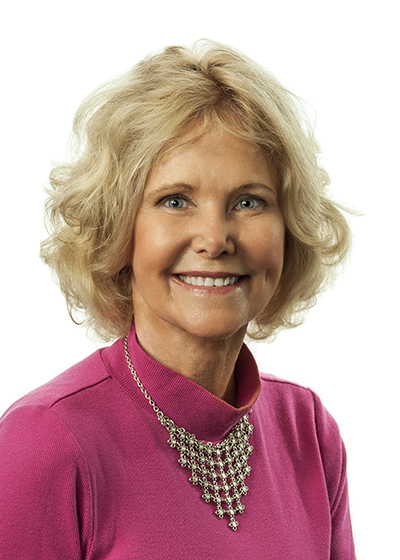
Every year, the National Alliance for Partnerships in Equity (NAPE) presents the Diversity in Technology Leadership Award. This year’s awardee is our director, Sheryl Burgstahler. The Diversity in Technology Leadership Award recognizes a role model who embodies NAPES’s core values to increase diversity, equity, and inclusion of underrepresented groups in STEM. Their mission is “to build the capacity of those in education to implement effective solutions to increase student access, educational equity, and ultimately workforce diversity.”
Those who are familiar with Sheryl and her work understand that she firmly believes individuals with disabilities are too often left out of education, business, civic duty, policy-making, and community life. She has spent much of her career promoting the use of technology to address this critical issue.
As stated in the award nomination, “Dr. Burgstahler lives and breathes the idea that diversity of thought enhances communities and has profound impact on individuals, our region, and the world. She has mobilized countless people to engage technology to provide equal access to individuals with disabilities on the University of Washington campus, at the state and local level, and on a national and international scale. Her creativity and dedication has brought people together and facilitated unimaginable projects in the field of technology and disability. This work has unlocked the potential of countless ‘thought leaders’ from underrepresented groups that would have otherwise not had a voice at the table—primarily for individuals with disabilities, but others that include English-language learners, women, racial/ethnic minorities, first generation college students, persons of low socio-economic status, and individuals that may belong to more than one underrepresented or underserved group.”
Read more about the Diversity in Technology Leadership Award and past award winners on the NAPE website.
Congratulations, Sheryl! We are proud of your accomplishments and are honored to work alongside you to tackle some of society’s most challenging issues.
Making Online Learning and Resources Accessible During COVID-19
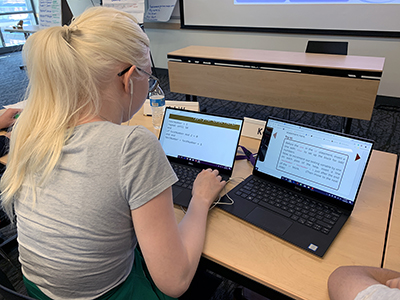
In response to the outbreak of COVID-19, institutions are converting on-site services and resources to online alternatives. DO-IT is doing its part to encourage these organizations to consider accessibility issues in these efforts. We encourage institutions to use accessible design, as well as offer accommodations as needed. Following is the message we promoted to encourage faculty and staff to consider accessibility as they are being asked to move courses, services, and resources online:
As you or your colleagues move courses/services/resources online, consider making them accessible to students, faculty, staff, and visitors with disabilities. To do so, consult our IT accessibility website. Those new to digital accessibility should select the “Getting Started” link from that page.
Those looking for a short list of guidelines for making courses and websites accessible to individuals with disabilities should consult:
- 20 Tips for Teaching an Accessible Online Course
- 30 Web Accessibility Tips
- 20 Tips for Offering Accessible Online Campus Services
For each of our resources, our HTML version of the content is the landing page with a link to a PDF that people often prefer for printing. Although our PDFs are accessible as well, one option for units that push back on going through the process of remediation of their inaccessible PDFs is to post content in an accessible HTML page and from there link to the inaccessible PDF they already have.
DO-IT continues to create, update, and promote our resources to encourage all educators to design content with accessibility in mind.
Online RESPECT Conference and Paper on Disability Data
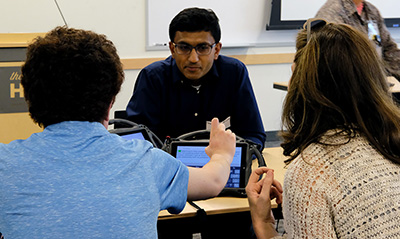
Every year, many of us from AccessComputing head to the RESPECT (Research in Equity and Sustained Participation in Engineering, Computing, and Technology) and SIGCSE (Association for Computing Machinery Special Interest Group on Computer Science Education) conferences, which are held back-to-back in February or March. This year, RESPECT and SIGCSE were scheduled for March 10-14, 2020 in Portland, OR. Just a few days ahead of time RESPECT, the smaller of the two conferences, pivoted to an online format. SIGCSE was set to go on as planned and pre-conference sessions were held March 10th. On the morning of the 11th, just as the main conference sessions were to begin, the Governor of Oregon banned large gatherings and the SIGCSE conference was canceled.
The RESPECT organizers did an amazing job shifting to an online conference. They used Zoom for each of the sessions with extensive use of the breakout room features to foster small group conversations and networking. Even though we were all spread out across the country, it was a great opportunity to catch up with our broadening participation in computing (BPC) colleagues nationwide.
It also meant that Richard Ladner and I were still able to present our research paper: Why is Data on Disability So Hard to Collect and Understand? The paper was written to serve as a call to action for our BPC colleagues to collect data on disability. Most BPC work focuses on gender and/or race. Occasionally disability is mentioned, but data on disability status of students and professionals is rarely collected. When it is collected, it varies dramatically depending on the way that questions are asked and is often not analyzed or discussed.
Are you considering how you can collect data about individuals with disabilities in your department, classes, or projects? We suggest using these two questions:
- Do you identify as having a disability or other chronic condition?
- Yes
- No
- Prefer not to disclose
- How would you describe your disability or chronic condition?
- Attention deficit
- Autism
- Blind or visually impaired
- Deaf or hard of hearing
- Health-related disability
- Learning disability
- Mental health condition
- Mobility-related disability
- Speech-related disability
- Other (please specify)
Be "LinkedIn" to Accessibility
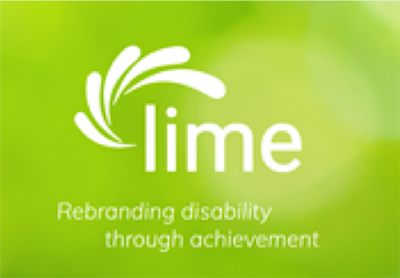
Various steps in your career journey, such as resume building, job hunting, or applying for internships, can feel overwhelming in the ever-changing job market.
LinkedIn has become the Facebook of professionals and Lime is the LinkedIn of accessibility. Lime Connect considers itself a “global not-for-profit organization that’s rebranding disability through achievement.”
Lime’s platform was developed to increase accessibility within the job searching platforms. One of the many examples on how they increase accessibility is by using a dyslexia-friendly font called Dyslexie. With one click of a button, the website will switch all its fonts to Dyslexie, making it easier for word processing.
Creating a profile on Lime Connect can outline valuable information to have in a resume. This is a place to keep track of achievements and past experiences, which are useful when needed to specialize your resume. You even have the option to not publish your profile, if you prefer privacy. If you already have an existing LinkedIn profile, (which is a career tool I highly recommend), you can also link it to your Lime Connect profile.
Lime Connect offers a variety of free professional development webinars. These webinars focus on a variety of topics such as career development and disability in the workplace.
One recent webinar called Strategies for a Successful Internship explained how to talk about your disability at work and how to get the most out of your internship. Another webinar called A Discussion on Mental Health: Strategies for Navigating the Workspace, was hosted by Katherine Switz, the Founder and Executive of the Many Minds Collaborative and The Stability Network. Katherine shared her story and the strategies she uses in the workplace. Lime Connect also offers online career counseling and coaching appointments.
After sending in a job application and resume, the last step is the interview. The interview is often the most anxiety-inducing part of the application process. The best way to tone down your anxieties is through practice. Lime offers mock interviews to prepare yourself.
The mock interviews are tailored to various types of careers. These interviews last about 30 minutes and have about 11 questions. Before an interview, it is always good to practice and think about the possible questions you might be asked. Using these tools will allow you to feel more confident when you go into a real interview.
Applying for internships, jobs, and career-building programs is hard. Every week it seems I am editing or remaking a resume. Putting yourself out there is awkward at first, but Lime Connect is a resource that can help ease that transition.
Remember that DO-IT is also a great resource. DO-IT staff are happy and available to help guide you to success. DO-IT staff can give you resume feedback or interview prep. You can also reach out to the DO-IT community for general advice and tips or just to share your success!
Recent AccessComputing and AccessCSforAll Webinar Recordings
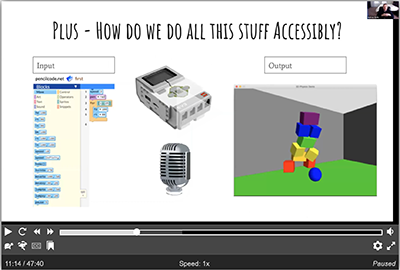
Over the past few months, AccessComputing and AccessCSforAll have held several webinars relevant to computing education and employment for individuals with disabilities. Recordings on these webinars are available in an accessible video-player with open captions on our Webinar page. Here are three of our most recent webinars:
Blocks4All
Lead by Lauren Milne (Macalester College) on Feb 11, 2020
Lauren Milne is an assistant professor at Macalester College. Her research is on making programming more accessible for children with visual impairments. She will be doing a demo of Blocks4All, an iPad application she developed, which can be used to program the Dash and Dot robots from Wonder Workshop, which is accessible with VoiceOver and Switch Control.
Inclusive Hiring
Lead by Neil Barnett (Microsoft) and Lorne Needle (Google) on Feb 07, 2020
You may have heard that many companies are stepping up their efforts to hire people with disabilities. In this webinar, we’ll hear from representatives at Microsoft and Google about what their companies are doing. Neil Barnett started Microsoft’s Autism hiring program in 2015 and is leading the efforts to improve the experiences for Microsoft employees and their customers with disabilities. Lorne Needle is Google’s global lead for disability inclusion in staffing and has led multiple talent initiatives.
Quorum Studio: Into Accessible Graphics
Lead by Andreas Stefik (University of Nevada Las Vegas) on Jan 14, 2020
The Quorum Programming Language is the first evidenced-oriented programming language that was “born accessible” more than ten years ago. New is Quorum Studio, an accessible integrated development environment (IDE) to support programmers in Quorum. Quorum Studio is built on the same design principles as the language itself, making it accessible to all users. In the first version, we have created a full development environment for editing, navigating, compiling, debugging, and executing applications, in addition to typical help features (e.g., highlighting, code completion, projects, updates) and accessibility features (e.g., smart zoom, smart navigation, a highly customized screen reading experience). Quorum Studio is also a platform for future accessible growth, with 3-D visual level editing, still fully accessible even if the user is blind, coming in the summer of 2020 in Quorum Studio 2.
We’re looking to hold more webinars over the coming months. If there is a topic you’d like to see DO-IT address in a webinar, please email us at doit@uw.edu.
Tech Tip: Saving and Reading Aloud Web Pages Using iOS
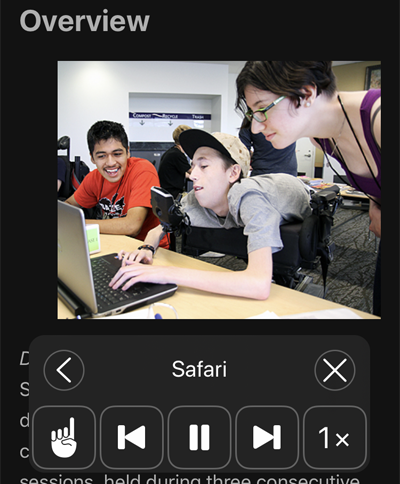
I often want to read articles while commuting on public transit; however, this can give me motion sickness. An alternative to reading by sight is using the built-in accessibility feature in Apple’s iOS called Speak Screen. This allows me to use headphones (or if I’m at home, just turn on my audio) to listen to any web page I want.
Here are the steps for turning on the Speak Screen functionality:
- Click settings icon in iOS
- Click the Accessibility icon on the settings page
- Click on Spoken Content on the Accessibility page
- Toggle on Speak Screen and scroll down the page to pick a choice in Voices, as well as a speaking rate. (Note: You may need to download another voice to suit your preferences.)
The best way to use this to read articles is using “Reader View,” an option that will strip out extraneous content from that page like menu items, links to other articles, and other unnecessary content.
When you find an article on Safari you’d like to have the iOS read aloud to you, click on the “AA” in the address bar. Here you’ll see a choice to pick Show Reader View (Sometimes that choice will be greyed out if the page is still loading, though occasionally it will stay grey and not offer Reader View mode).
Swipe down from the top edge of the screen with two fingers to activate Speak Screen, which will bring up a tool bar atop the article. This toolbar includes a hand symbol that allows you to select a section of text to just read from that point on. There is also a back arrow, a pause icon, and a forward arrow to advance in the article. Lastly there is a reading speed option that remembers your last choice and defaults at 1x rate.
This toolbar will shrink or contract back to the edge of the screen while being somewhat transparent to open it again to make adjustments.
If you’re likely to lose Internet connectivity during your desired reading time, apps like Instapaper allow you to save an article from Safari to then read in the same Speak Screen mode as mentioned above. It is important to open Instapaper first and have it download all your saved article links before embarking on your travels.
Another good app to try is Voice Dream reader which is also great for reading saved articles and uses its own voices and controls instead of iOS’s built-in reading functionality.
About DO-IT
DO-IT (Disabilities, Opportunities, Internetworking, and Technology) serves to increase the successful participation of individuals with disabilities in challenging academic programs and careers, such as those in science, engineering, mathematics, and technology. Primary funding for DO-IT is provided by the National Science Foundation, the State of Washington, and the U.S. Department of Education.
For further information, to be placed on the DO-IT mailing list, request this newsletter or other materials in an alternate format, or make comments or suggestions about DO-IT publications or web pages, contact us at

DO-IT
University of Washington
Box 354842
Seattle, WA 98195-4842
doit@uw.edu
www.uw.edu/doit/
206-685-DOIT (3648) (voice/TTY)
888-972-DOIT (3648) (toll free voice/TTY)
509-328-9331 (voice/TTY) Spokane
206-221-4171 (fax)
Founder and Director: Sheryl Burgstahler, Ph.D.
Program Manager: Scott Bellman